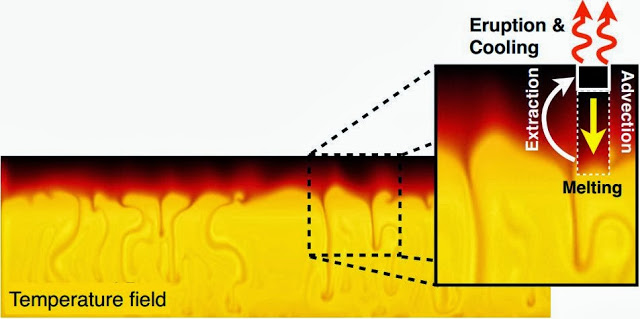
Two planetary researches, one from Hampton University and the National Institute of Aerospace, the other from Louisiana State University, have published a paper in the journal Nature suggesting that for a period of time, the Earth was very similar to Jupiter’s moon Io—with heat from within being released through what are known as heat-pipes. The new theory by William Moore and Alexander Webb goes against the common consensus that the Earth transitioned directly from a planet with a hot molten liquid layer to one covered by tectonic plates.
Planetary scientists have been stumped in trying to figure out how a planet with a molten hot liquid surface could transition directly to one with tectonic plates—the only way that could happen would be if the planet cooled almost instantly. But all available evidence indicates it didn’t, so how did the tectonic plates come about? Moore and Webb suggest there was an intermediate stage—one where heat was allowed to escape from the interior of the planet through heat-pipes.
In practical terms, heat pipes are soft material “holes” in a planet’s surface. Hot magma from below is pushed upwards through channels towards the surface where it flows out as lava allowing heat to escape into space. While very similar to volcanoes, they don’t necessarily erupt, they simply ooze. Jupiter’s moon Io is an excellent example of a body that oozes lava, with so many heat-pipes that its entire surface is covered by material constantly pushed up from below. The result is a constant turnover of surface material, mixing with that from below. Moore and Webb theorize that a very similar situation existed on Earth between the time the surface was hot molten liquid and the development of tectonic plates. They suggest the constant movement of material up though the heat-pipes led to a build-up on the surface. As the planet cooled over time, the material that was pushed up slowly hardened and became the tectonic plates. And because there was still a lot of heat in the core of the planet, fissures developed which caused the plates to break apart and to travel as they continue to do today.
Moore and Webb point to ancient zircon and diamonds found on Earth to strengthen their theory—the rocks have been dated to the time period in question (roughly 3 to 4 billion years ago) and show the weathering that would have occurred had they been constantly churned by heat-pipe transport.
More information: Heat-pipe Earth, Nature 501, 501–505 (26 September 2013)
DOI: 10.1038/nature12473
Note : The above story is based on materials provided by Nature










